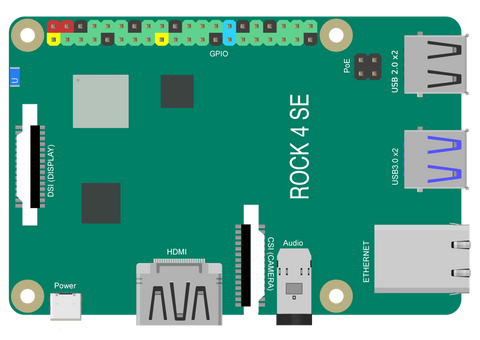Introduction: When it comes to single-board computers, the Raspberry Pi has undoubtedly captured the hearts of hobbyists and DIY enthusiasts worldwide. However, a new contender has emerged that promises even greater performance, availability, and several other advantages. Enter the Rock Pi 4, a powerful alternative that deserves your attention. In this blog post, we will explore the reasons why buying a Rock Pi 4 might be the right choice for you, especially when compared to the popular Raspberry Pi module.
1.Unleash the Power: The Rock Pi 4 packs a punch with its impressive hardware specifications. Equipped with a Rockchip RK3399 hexa-core processor and a Mali-T860 MP4 GPU, this SBC offers superior computing power and graphic capabilities. Compared to the Raspberry Pi, the Rock Pi 4 can handle more demanding tasks, such as AI applications, multimedia processing, and 3D gaming. So, if you're looking for a board that can handle intensive workloads, the Rock Pi 4 has got you covered!
2.Expanded Connectivity Options: The Rock Pi 4 offers a range of connectivity options, including Gigabit Ethernet, Bluetooth 5.0, and USB 3.0 ports, providing faster data transfer speeds and better connectivity overall. This is particularly advantageous if you're working on projects that require high-speed networking or external storage devices. While the Raspberry Pi also provides connectivity options, the Rock Pi 4 takes it a step further, enabling more versatile and efficient project setups.
3.Enhanced Memory and Storage: The Rock Pi 4 supports up to 4GB LPDDR4 RAM, ensuring smooth multitasking and efficient performance. Additionally, it offers an eMMC socket for faster and more reliable storage options compared to the microSD cards commonly used with the Raspberry Pi. With the Rock Pi 4, you'll experience improved responsiveness and reduced latency, making it ideal for applications that demand high memory and storage capabilities.
4.GPU Acceleration: The Rock Pi 4's Mali-T860 MP4 GPU delivers excellent graphics performance. It supports OpenGL ES 1.1/2.0/3.0, Vulkan 1.0, and OpenCL 1.2, providing hardware acceleration for graphical tasks. This feature is especially beneficial for gaming enthusiasts and developers working on graphics-intensive projects. While the Raspberry Pi's GPU is capable, the Rock Pi 4's GPU takes performance to the next level, ensuring a more immersive and visually stunning experience.
5.Availability and Community Support: One of the main concerns when purchasing a single-board computer is availability. The Raspberry Pi has a vast community and extensive ecosystem, which undoubtedly contributes to its popularity. However, the Rock Pi 4 is gaining traction rapidly, and its availability is increasing as more users discover its potential. While the Rock Pi 4's community might not be as large as the Raspberry Pi's, it's growing steadily, with active forums, online communities, and dedicated support channels. Rest assured, you won't be alone in your journey with the Rock Pi 4.
Conclusion: Okdo ROCK 4 Model C+ Single Board Computer presents a compelling alternative to the Raspberry Pi, offering superior performance, expanded connectivity options, enhanced memory and storage, powerful GPU acceleration, and an increasingly supportive community. If you're searching for a single-board computer that can handle more demanding tasks and provide a robust platform for your projects, the Rock Pi 4 is undoubtedly worth considering. Embrace the power of the Rock Pi 4 and take your DIY projects to new heights!
Comparison Table :
| Model | ROCK 4 SE | ROCK 4 C PLUS |
 |

|
|
| Processor | 64bit hexa core processor Rockchip RK3399-T Dual Cortex-A72, freqency 1.5Ghz with quad Cortex-A53, frequency 1.0Ghz Mali T860MP4 gpu OpenGL ES 1.1 /2.0 /3.0 /3.1 /3.2, Vulkan 1.0, Open CL 1.1 1.2, DX11. |
64bit hexa core processor Rockchip RK3399-T Dual Cortex-A72, freqency 1.5Ghz with quad Cortex-A53, frequency 1.0Ghz Mali T860MP4 gpu OpenGL ES 1.1 /2.0 /3.0 /3.1 /3.2, Vulkan 1.0, Open CL 1.1 1.2, DX11. |
| Memory | LPDDR4 64bit dual channel LPDDR4@3200Mb/s, 2GB/4GB optional |
LPDDR4 64bit dual channel LPDDR4@3200Mb/s, 2GB/4GB optional |
| Storage | eMMC connector Optional industrial compatible high eMMC module, 8G/16G/32G/64G/128G available uSD card uSD slot supports up to 128G uSD card M.2 SSD M.2 connector supports up to 2T M.2 NVME SSD |
eMMC connector Optional industrial compatible high eMMC module, 8G/16G/32G/64G/128G available uSD card uSD slot supports up to 128G uSD card |
| Camera | MIPI CSI MIPI CSI 2 lanes via FPC connector, support up to 800MP camera(1mm pitch connector) |
MIPI CSI MIPI CSI 2 lanes via FPC connector, support up to 800MP camera(0.3mm pitch connector) |
| Wireless | WiFi5 / BT5 default on board antenna, external antenna sku available |
WiFi5 / BT5 with external antenna(included) |
| Display | HDMI Full size HDMI 2.0 up to 4k@60(Type A) MIPI DSI MIPI DSI 2 lanes via FPC connector HDMI and MIPI DSI can work at the same time, support mirror mode or extend mode. |
2x micro HDMI Dual display via two micro HDMI 1x HDMI 4Kp60, 1x HDMI 2Kp60 MIPI DSI MIPI DSI 4 lanes via FPC connector(to use MIPI DSI, one HDMI must be disabled) |
| Audio | 3.5mm Headphone Jack HD codec that supports up to 24-bit/96kHz audio. |
3.5mm Headphone Jack HD codec that supports up to 24-bit/96kHz audio. |
| USB | USB 3.0 OTG x1 hardware switch for host/device switch, upper one USB 3.0 HOST x1 dedicated USB3.0 channel, lower one USB 2.0 HOST x2 |
USB 3.0 OTG x1 hardware switch for host/device switch, upper one USB 3.0 HOST x1 dedicated USB3.0 channel, lower one USB 2.0 HOST x2 |
| Ethernet | GbE LAN with PoE support additional HAT is required for powering from PoE |
|
| IO | No | No |
| Others | Fan 2P PWM Fan header |
|
| Power | USB C USB C 5V/3A GPIO +5V Power from GPIO pin2&4 |
|
| Size | 85mm x 54mm | 85mm x 54mm |

